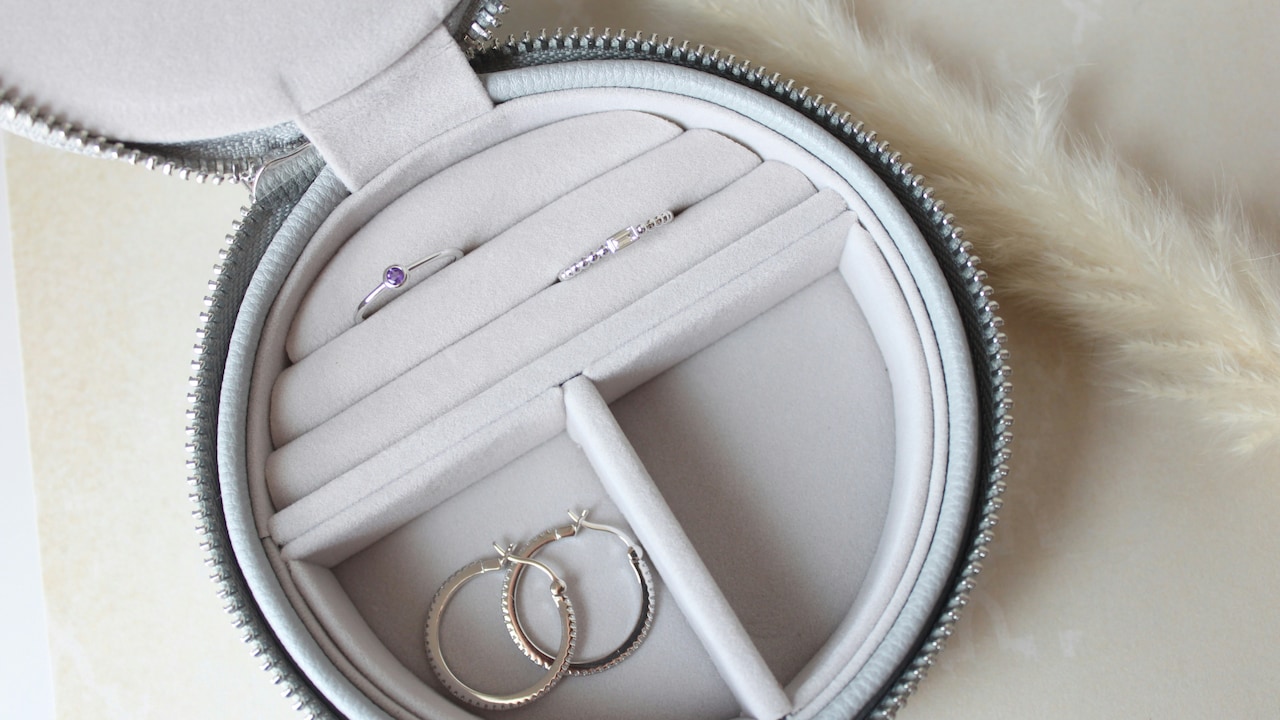Can Jewellery Organisers Prevent Tarnish? The Science Behind It
Jewellery often loses its shine far sooner than expected, especially in warm, humid homes. Many blame poor-quality metal, but storage habits play a much bigger role. Explore whether jewellery organisers truly prevent tarnish and how they work.

How Jewellery Organisers Prevent Tarnish: Proven Tips And Science Explained.
Jewellery holds stories, weddings, anniversaries, festive gifts, impulse buys, and heirloom treasures passed down with pride. Yet nothing feels more disappointing than opening a box to find a favourite piece dull, patchy or discoloured. Tarnish creeps in quietly, often faster than one expects, particularly in homes where summers feel endless and monsoons leave a trail of humidity in every corner.
Many households rely on soft pouches, velvet boxes or zip bags, while others invest in elaborate organisers that promise to preserve shine. But do they truly help? Can a carefully designed organiser stop metals from reacting with the environment? And is it worth spending extra on storage instead of frequent polishing?
To answer these questions, this article explores science, everyday habits and the design features that offer real protection. Whether a collection includes gold, silver, copper alloys or fashion jewellery, small shifts in storage can make a big difference. Let's look at the ideas behind these organisers and whether they genuinely make jewellery last longer. So, learn here why jewellery tarnishes and how jewellery organisers can make a world of difference.

Can Jewellery Organisers Prevent Tarnish? The Science Behind It; Photo Credit: Pexels
Why Jewellery Tarnishes and How Storage Makes a Difference
1. Understanding How Tarnish Actually Forms
Tarnish looks like a simple layer of dullness, but it comes from a slow, steady reaction between metal and the air around it. Silver reacts with sulphur compounds; copper reacts with oxygen; even gold, though resistant, can still gather grime from sweat, perfume and dust. Every day surroundings are full of tiny particles that cling to metal surfaces, cooking fumes, humidity and even the air from open drains. These settle on jewellery over time and create a thin film that distorts the original shine.
In many homes, jewellery is stored in open trays or cloth pouches. When moisture rises during monsoon, metal becomes more vulnerable because damp air speeds up chemical reactions. Storing jewellery near bathrooms, windows or kitchens exposes it to steam and pollutants. Many people also keep pieces in cotton pouches believing they are safe, but cotton traps moisture and speeds up tarnish. When jewellery stays exposed to shifting temperatures and airborne chemicals, it ages quickly. Understanding this reaction highlights why the right storage matters and why organisers claim to control the environment around jewellery.
2. How Jewellery Organisers Control Moisture
Humidity plays the biggest role in tarnish. When the air becomes heavy with moisture, metals react faster with oxygen and sulphur compounds. Organisers designed for jewellery try to create a controlled microenvironment. They use lined compartments, tight closures, and sometimes moisture-absorbing inserts to keep humidity low.
In many homes, cupboards and drawers get humid due to weather changes, damp walls or occasional water seepage. Jewellery placed in these spaces absorbs moisture and develops spots, especially silver chains and copper-based bangles. Organisers that use fabric like suede or velvet absorb excess moisture, reducing direct contact with the metal. Some organisers also include small silica gel packets that keep the compartment dry throughout the year.
Moisture control becomes even more important for pieces used only during festivals or weddings because they spend long periods untouched. Without a dry space, these pieces often come out looking older than expected. By limiting humidity inside the box, organisers delay tarnish and keep polishing needs to a minimum.
Also Read: Before And After: How These 10 Jewellery Organisers Transformed My Styling Experience
3. Preventing Contact with Air Pollutants
Everyday air contains impurities from cooking, cleaning agents, incense, vehicles and dust from open windows. These pollutants react with metal surfaces, making jewellery look dull or patchy. Organisers act as protective shields by reducing exposure to these airborne particles. Closed lids, zip compartments and structured drawers block most pollutants from settling on jewellery.
Homes near busy roads or construction zones often deal with more dust. When dust settles on jewellery, it traps moisture and creates a rough texture. This speeds up tarnish and leads to scratches when pieces rub against each other. Organisers reduce this problem by sealing compartments so dust cannot enter easily.
Sulphur compounds found in common household products like rubber bands, hair sprays and certain fabrics also react with metals. Keeping jewellery in open trays exposes pieces to these silent culprits. Storing them inside organisers reduces interactions with such chemicals. As a result, the shine stays intact much longer.
4. Cushioning and Compartmentalisation Reduce Damage
Jewellery stored together often rubs, scratches and tangles. Even minor abrasions make pieces look older and encourage tarnish because damaged surfaces react faster with air and moisture. Organisers with multiple compartments protect each piece by keeping them separated and cushioned.
Necklaces often tangle when placed in soft cloth bags, and trying to separate them stretches chains or bends hooks. When scratches appear, the metal surface loses its smooth finish and darkens quickly. Proper organisers provide hooks, slots and padded sections that keep each piece in place.
Earrings, particularly delicate studs and jhumkas, lose lustre when pressed under heavier pieces. Bangles and bracelets develop scuff marks if stored without cushioning. Organisers with velvet or suede lining prevent jewellery from scraping against hard surfaces. By reducing physical damage, organisers effectively slow down the entire tarnishing process.

Can Jewellery Organisers Prevent Tarnish? The Science Behind It; Photo Credit: Pexels
5. Temperature Stability Helps Preserve Shine
Temperature fluctuations influence how metals react. Sudden heat or cold makes metal expand or contract slightly, causing stress on the surface. This stress encourages reactions and attracts moisture from the air. Organisers keep jewellery in one stable environment instead of letting it face the changing temperatures inside a room.
In many homes, jewellery stays in dressing tables near windows where sunlight warms the drawers during the day and cools them at night. These shifts speed up tarnish. Similarly, keeping jewellery in metal boxes amplifies temperature changes because metal conducts heat quickly. Organisers made of wood, faux leather or high-quality fabric maintain a more even temperature.
Stability is especially crucial for gold-plated and imitation pieces because their thin top layer reacts faster. When temperature swings become frequent, plating wears out and reveals darker metal underneath. A stable environment inside a well-built organiser slows this wear and keeps the finish looking fresh.
6. Anti-Tarnish Materials: Do They Really Work?
Some organisers include specific anti-tarnish materials designed to neutralise chemicals in the air. These may come as lining fabrics infused with compounds that absorb sulphur molecules or as pouches containing activated charcoal or treated paper. These materials trap pollutants before they can reach jewellery.
Silver pieces benefit most because silver reacts quickly with sulphur. When stored with an anti-tarnish lining, the reaction slows dramatically, giving the metal a chance to stay bright for months. Many people wrap silver in newspaper or cling film, but these methods trap moisture and cause uneven tarnish. Anti-tarnish materials provide a more dependable solution.
However, these materials have a lifespan. Their effectiveness reduces over time, especially in humid spaces. Replacing them every year or two ensures continued protection. While they cannot stop tarnish completely, they significantly delay the process and reduce the need for frequent polishing.
7. The Role of Organisation in Daily Habits
An organiser does more than protect jewellery; it shapes how people handle their collections. When jewellery has a dedicated place, it gets stored properly after every use. This small habit prevents accidental exposure to sweat, perfume and humidity.
After gatherings, many people leave jewellery on tables or dresser tops to deal with later. This exposes pieces to dust and moisture for hours or even days. Organisers make it easy to sort items into their compartments, encouraging immediate storage. This simple routine reduces the chances of tarnish.
Keeping jewellery well organised also prevents accidental mixing of metals. Some metals influence each other when stored together. For instance, copper-based imitation jewellery can accelerate tarnishing on silver. With clear sections and trays, organisers prevent such contact and keep metals from affecting one another.

Can Jewellery Organisers Prevent Tarnish? The Science Behind It; Photo Credit: Pexels
8. Travel-Friendly Organisers Reduce On-the-Go Damage
Travelling exposes jewellery to stress, humidity and rough handling. Many travellers place pieces in small pouches, only to find them tangled or dull upon reaching their destination. Travel organisers keep pieces safe with secure slots, zips and cushioned folds.
When bags go through airports, trains or long road journeys, vibrations and movement cause jewellery to rub and clash. This friction creates scratches that darken over time. Organisers designed for travel prevent movement by anchoring each item in a fixed position.
Some travel organisers use moisture-resistant materials to protect jewellery from humid hotel rooms or seaside climates. This extra protection helps preserve shine, especially on silver and imitation pieces. By reducing physical and chemical stress during travel, organisers keep jewellery looking new for longer.
9. Choosing the Right Organiser for Your Collection
Not all organisers suit every collection. Delicate chains need hooks, bangles need sturdy compartments and earrings need soft padding. Choosing the right organiser depends on the type of jewellery owned and the environment in which it will be stored.
Fabric-lined organisers work well for everyday pieces because they offer moisture control and cushioning. Hard-case organisers suit heavy jewellery sets worn during weddings or festivals. For people living in humid regions, organisers with silica gel slots provide extra protection.
Budget also plays a role. A simple organiser costs around ₹500, while large multi-layer boxes may go up to ₹5,000 or more. The right choice should balance cost with features and long-term protection. A well-chosen organiser reduces the need for frequent polishing and keeps a collection looking festive-ready at all times.
10. Limitations: What Organisers Cannot Prevent
Organisers offer strong protection, but they cannot stop tarnish entirely. Metals react naturally, and some reactions happen even in the best-controlled environments. Sweat and perfume left on jewellery after use continue to act on the metal inside the organiser unless cleaned first.
Organisers also cannot repair existing tarnish. If a piece looks dark or dull, cleaning becomes necessary before storing. Without cleaning, tarnish spreads faster even inside sealed compartments. Additionally, cheaper organisers made from low-quality materials may trap moisture instead of reducing it.
Organisers help delay tarnish, not eliminate it. Proper cleaning, careful handling and mindful storage habits work together with organisers to keep jewellery shiny. Understanding these limitations helps set realistic expectations and encourages better care routines.
Products Related To This Article
1. YouBella Jewellery Organisers
2. Portable Travel Jewellery Box
3. Portable Travel Jewellery Box
4. atorakushon Satin Makeup Pouches Cosmetic Necklace Earrings
5. Kuber Industries Cotton Jewellery Kit With 10 Pouches
Jewellery organisers genuinely help prevent tarnish by controlling moisture, reducing exposure to pollutants, avoiding scratches and stabilising temperature. They serve as a protective environment where metal gets a chance to retain its original brilliance. While they cannot stop natural reactions completely, they delay the process enough to keep jewellery looking fresh for years.
With thoughtful storage, regular cleaning and the right organiser, precious pieces stay festival-ready every time they are taken out. A little care at home saves time, money and the heartbreak of seeing a favourite piece lose its shine. The right organiser becomes more than a box, it becomes a guardian of memories, moments and all the sparkle that comes with them.
(Disclaimer: This article may include references to or features of products and services made available through affiliate marketing campaigns. NDTV Convergence Limited (“NDTV”) strives to maintain editorial independence while participating in such campaigns. NDTV does not assume responsibility for the performance or claims of any featured products or services.)
























